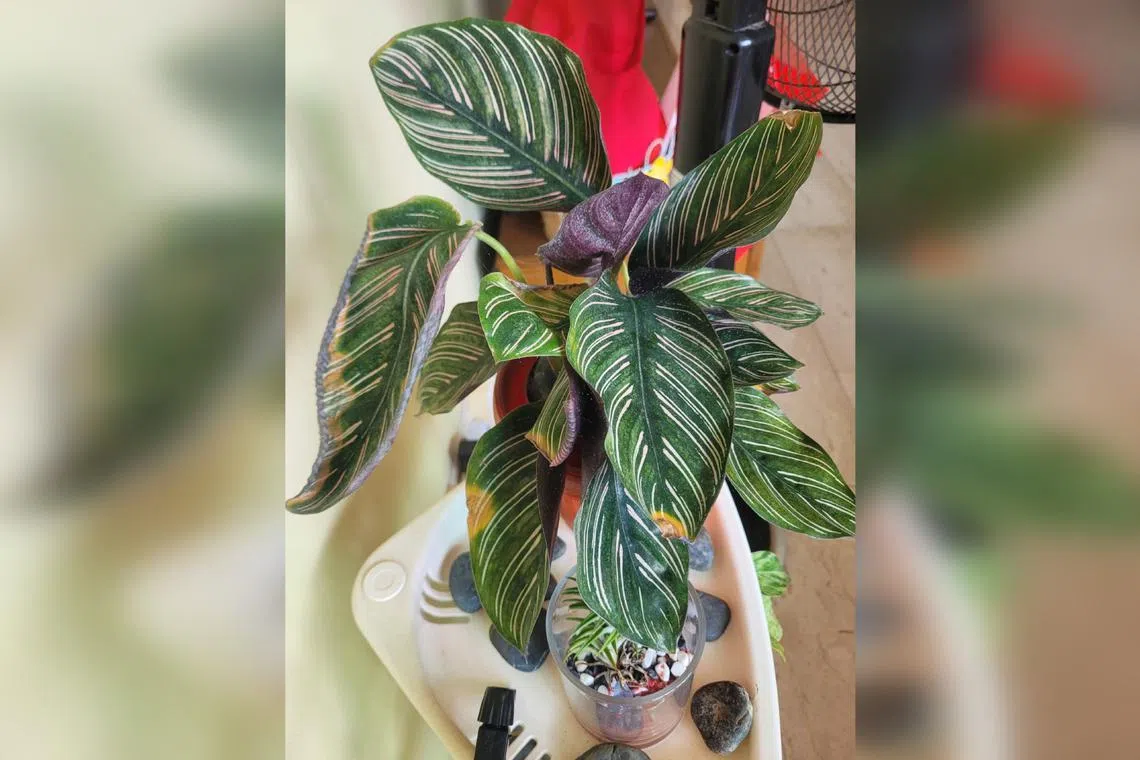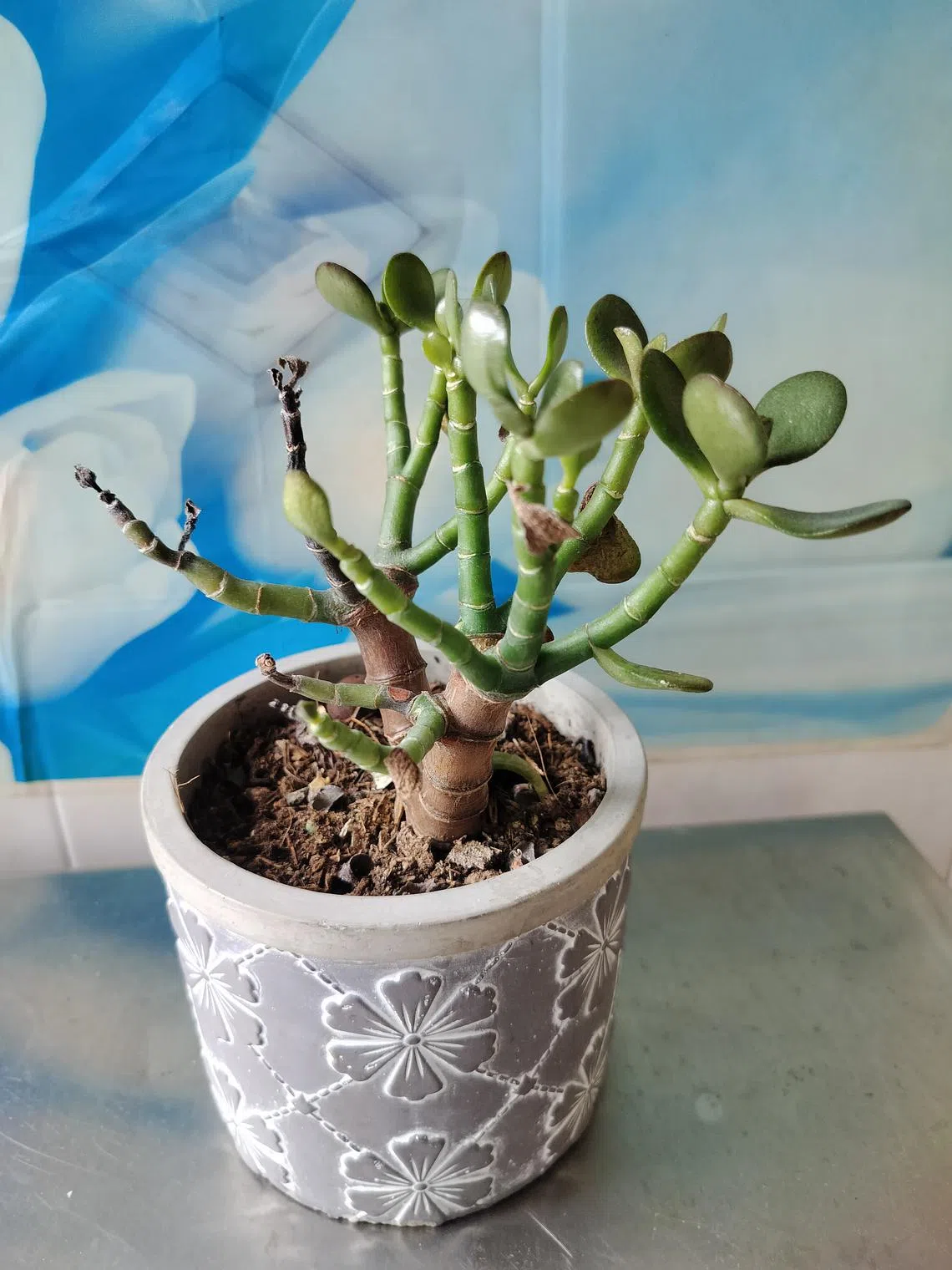Root Awakening: Prayer Plant difficult to grow in high-rise homes
Sign up now: Get ST's newsletters delivered to your inbox

The speckled patterns also indicate a spider mite infestation, which can be difficult to control.
PHOTO: SOH MEI LIN
Wilson Wong
Follow topic:
Brown patches on leaves could be due to fertiliser toxicity
Why have the leaves of this plant turned yellowish brown?
Soh Mei Lin
The Prayer Plant can be difficult to grow in a high-rise environment, as it requires high humidity to thrive. High-rise homes can be windy and dry, and leaves tend to curl up in protest. The speckled patterns also indicate a spider mite infestation, which can be difficult to control.
You can increase the ambient humidity by using a humidifier. Regular misting will also help wash off the spider mites.
The brown necrotic patches on the leaves could be due to toxicity from accumulated fertiliser salts or fluoride in municipal water. Use slow-release fertilisers and rain water to feed and irrigate your plant.
Jade Plant needs cooler, brighter conditions

Tropical heat can cause the Jade Plant to weaken and decline over time.
PHOTO: ELLEN YIANG
Why is my Jade Plant rotten? I keep it indoors and water it once a week.
Ellen Yiang
The Jade Plant can be challenging to grow in Singapore, as it fares better in areas with cooler nights. Tropical heat can cause the plant to weaken and decline over time.
If you like sculptural succulents, select those that are more suited to Singapore’s climate, such as species from the genus Euphorbia.
Also, the sun-loving Jade Plant should not be grown in deep shade or it will decline. Give it at least four hours of direct sunlight daily for optimal growth.
Check root health of Cordyline plants

The browning leaves could be due to an injury from fertiliser, pesticide or another chemical.
PHOTO: KEITH TAN
What is wrong with my Cordyline plants?
Keith Tan
Without further details on cultivation conditions and recent interventions, it can be difficult to discern what has happened to your plants.
The browning leaves could be due to an injury from fertiliser, pesticide or another chemical. Certain chemicals can damage plant tissues and cause the leaves to turn necrotic. Always test new chemicals on a small part of the plant and use lower doses when trying them for the first time.
Also, check if the plants are overwatered or in soggy soil. Waterlogged conditions can kill roots due to the lack of oxygen and build-up of toxic substances in the root zone. The plant will be unable to take up water and its tissues may be damaged.
If this is the cause, you will need to improve the soil drainage. Stem cuttings can be taken to propagate new plants, which can be grown in a more suitable location.
Ixora fruit can be eaten

The Ixora plant seldom fruits in Singapore.
PHOTO: SENG HUAT SEAH
What is this plant? I saw it along the Rail Corridor and it had ripened berries. Are these edible?
Seng Huat Seah
The plant appears to be an Ixora and is seldom seen fruiting in Singapore. The fruit is edible but, depending on the cultivar, may not be palatable.
Answers by Dr Wilson Wong, an NParks-certified practising horticulturist and parks manager. He is the founder of Green Culture Singapore and an adjunct assistant professor (Food Science & Technology) at the National University of Singapore.
Have a gardening query? E-mail it with clear, high-resolution pictures of at least 1MB, if any, and your full name to . We reserve the right to edit and reject questions.
Check out free gardening events in August at HortFest 2025 (
go.gov.sg/hortfest2025
), taking place at HortPark until Aug 31, 9am to 7pm daily. Among these are two talks by Dr Wilson Wong on Aug 31: Low-Maintenance Edible Plants (Multi-Purpose Hall, 1.30 to 2.30pm) and Getting To Know Unusual Edibles (Event Lawn, 3.30 to 4.30pm).

